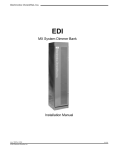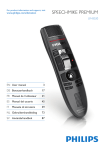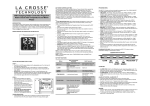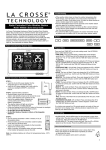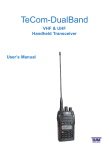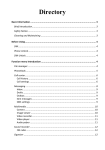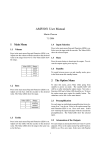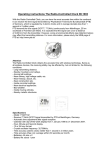Download LED Weather Station with 433 MHz Remote Sensor
Transcript
LED Weather Station with 433 MHz Remote Sensor User’s Manual Introduction Congratulations on your purchase of this new Weather Station with LED display. This unique product is designed for everyday use for the home or office and is a definite asset of great use. To fully benefit from all the features and understand the correct operation of this product, please read this instruction manual thoroughly. FUNCTIONS OF THE WEATHER STATION This LED weather station measures the ambient temperature and atmospheric pressure for weather forecasting. Moreover, equipped with a 433MHz radio frequency (RF) interface, it can receive data from up to three remote sensors for outdoor temperature measurement within a distance of 100 feet (30 meters) in open space. The data is continuously updated and displayed on the LED panel of the weather station. FEATURES: MAIN UNIT A. IR motion sensor It is a motion sensing device to activate the snooze function, provided that an object (e.g. human hand) gets within an 8cm distance in front of the sensor, when the alarm is activating. B. Air pressure trend arrows It is to indicate the trend of atmospheric pressure changes C. Weather forecast icon Display the weather-forecast icons for sunny, slightly cloudy, cloudy, rainy and stormy. D. Low battery indicator It is to indicate the backup battery in the main unit when the battery power level is low. The user needs to change the batteries at once. Otherwise, the clock and alarm setting will be reset if the plug-in adaptor is disconnected. E. Clock time Display current time or alarm time F. Alarm on icon It is shown when the daily alarm is enabled. G. Radio controlled clock time indicator Appears to indicate the displayed clock time is a received RCC time H. Indoor temperature icon It is to indicate the indoor temperature is displayed I. Indoor maximum/minimum temperature icon It is to indicate the maximum/minimum indoor temperature that is being displayed J. Remote sensor battery low indicator It is shown when the batteries of the remote sensor are running low and the temperature measured by this sensor is no longer reliable. The user must change the batteries as soon as possible. K. Remote sensor indicator Indicates which channel of remote sensor is being displayed. It can display up to 3 different remote sensors which are in different locations and within 100 feet (30 meters) distance from the main unit. L. Outdoor maximum/minimum icon It is to indicate the maximum/minimum outdoor temperature that is being displayed M. Wall mounting hole For wall-mounting of the weather station DESCRIPTION OF BUTTONS The LED weather station has 8 buttons on the rear side 1. [ ] button - Press once to switch from clock mode to alarm time display mode - While in alarm display mode, press once to toggle between enable or disable the daily alarm - While in alarm display mode, press and hold for 2 seconds to enter alarm setting mode 2. [MAX/MIN] button - Toggle to display the Max/Min reading of the Indoor & Remote Temperature. - Press & hold for 2 seconds to clear the memorized Max/Min readings of the Indoor channel or the selected remote channel. 3. [MENU/SETUP] button Press and hold 2 seconds to enter clock setting mode 4. [CH] button - Select among channel 1, 2, 3 or to enter auto scroll mode. - Press and hold for 2 seconds to activate or deactivate the sensor searching mode 5. [ ] button Press once to increase the setting in CLOCK or ALARM setting mode 6. [ ] button Press once to decrease the setting in CLOCK or ALARM setting mode 7. [RESET] button Press once to trigger system reset and restore the factory default setting. 8. [BRIGHT/DIM] button Toggle to select a bright LED display or a dim LED display GETTING STARTED This Weather Station was designed for easy set up. The following steps are recommended for installation of the remote sensor and the weather station. 1. Install batteries in the remote sensor(s) prior to backup batteries and AC/DC adaptor installation in the weather station. 2. The following diagrams and steps illustrate the battery installation for remote sensor Open the battery compartment at the bottom of the outdoor sensor. Install 2 pieces of AA size batteries according to the polarity mark inside the battery compartment. Close the battery compartment of outdoor sensor. The transmission LED on the front of the outdoor sensor will start to flash for 10 seconds. The default flashing frequency is once per around 2 seconds to indicate this sensor will be registered on channel 1 if not set manually within 10 seconds. While the transmission LED is flashing, press once the [CH] button at the bottom of a remote sensor and it will flash twice per around 2 seconds to indicate this sensor will be registered on channel 2. Keep toggle on [CH] button can change channel setting up to 3 and then back to channel 1. 3. Backup battery and adaptor installation for main unit Take away the removable stand from the weather station. Open the battery compartment on the rear of the weather station. Install 2 pieces of AAA sized batteries according to the polarity mark inside the battery compartment. Close the battery compartment Put back the removable stand and place the weather station securely on a flat surface; or mount it on a wall without the removable stand Insert the plug of the AC/DC adapter into the DC 5V IN jack of the weather station and connect the adaptor to a wall outlet (100-240V AC). When the weather station is powered on, it will initiate the RF search mode to search if there is/are any remote sensor(s) within 100 feet (30 meters). Once a remote sensor is registered, this LED weather station will display its temperature in the corresponding remote channel. Note: This LED weather station must work with the adaptor. If the user removes the adaptor, the LED weather station will turn off the display, save the last reading of the temperature and weather forecast; keep running the internal clock with the backup battery. The LED weather station will start RF searching mode for 2 minute after plug in the adaptor. TRANSMISSION RANGE The maximum transmission range between remote sensor and weather station is 30m under optimum conditions in an open area. The actual distance will be reduced by many factors: Walls, reinforced concrete ceilings Trees, bushes, earth, rocks Metal & conducting objects (e.g. radiators) Broadband interferences in residential areas (DECT telephones, mobiles, radio controlled headphones, radio-controlled speakers, other radio-controlled weather stations, etc.) Manually (re-) register remote sensors If the remote sensor displays ‘--,-‘, it means the communication between the weather station and remote sensor is interrupted over 35 minutes. Firstly, please check the low battery icon in the remote sensor and replace the batteries if necessary. Secondly, manually (re-) register your remote sensor with below steps. • Remove the batteries from the remote sensor for a few seconds. • Re-install the batteries. The transmission LED will flash once every 2 seconds to indicate channel one is selected. • Set the desired channel Note 1. The transmission LED will flash twice every 2 seconds to indicate channel 2 is selected; flash thrice every 2 seconds to indicate channel 3 is selected. • Press and hold the weather station [CH] button for 2 seconds to activate RF search mode. There will be a brief beep and the remote sensor channel number (1-3) on the LED panel will flash. • Make sure that the remote sensor is installed within range (maximum 30m in an open area). • The weather station will detect the remote sensor and the remote sensor temperature will be displayed. • Press and hold the weather [CH] button for 2 seconds to exit search mode. • If no button is pressed, search mode will automatically stop after 2 minutes. Note: 1. Please refer to the “Getting started” section for remote sensor channel setup. DCF 77 RADIO CONTROLLED CLOCK The remote sensor receives the time signal transmitted by Physikalisch-Technische Bundesanstalt (PTB) of Germany, which is regulated by 4 atomic clocks and in average deviates less than 1 second in 2 million years. PTB transmits the time signal (DCF77, 77.5kHz) continuously from Mainflingen, 25 km southeast of Frankfurt (am Main). It is expected that the signal can cover a distance of 1,500 km from the transmitter. Then the remote sensor transmits the time signal to the weather station to display the accurate time. However, there are many environment factors may affect the RCC reception, i.e. nearby computer monitors or other electronic devices, put on any metal surface, surrounded by any tall buildings and so on. The user had better to place the remote sensor away from metallic structures and face the transmitter in Mainflingen-near Frankfurt, Germany. SET THE CLOCK Note 2 1. Press and hold the [MENU/SETUP] button for more than 2 seconds to enter clock setting mode, the hour value begins flashing at the frequency of 1Hz. 2. Press the [ ] or [ ] button once to increase or decrease the hour value by one hour. Hold down either button will initiate fast increment/decrement (with 10 increments/decrements per second). 3. Press the [MENU/SETUP] button to confirm the hour value. The minute value begins flashing at the frequency of 1Hz. 4. Press [ ] or [ ] button to set your desired minute value. Holding down either button will initiate fast increment/decrement (with 10 increments/decrements per second). Press the [MENU/SETUP] button to confirm the minute value. Note 3 Note: 2. If there is no key pressed in the setting mode for 10 seconds, it will automatically save the set value and exit to normal display. 3. Every change of minute digit will automatically reset the seconds to zero. TO SET DAILY ALARM Note 4 1. In the clock time display mode, press the [ ] button once to switch to display alarm time for 10 seconds. 2. Press the [ ] button again in alarm display mode to enable or disable the daily alarm. 3. In the alarm time display mode, press and hold the [ ] button for 2 seconds to enter the alarm setting mode. 4. The hour digits will be flashing, use the [ ] button to increase by one hour or the ] button to decrease by one hour to the desired hours. Holding down the button will initiate the fast increments/decrements. Press the [ ] button to confirm. 5. The minute digits will be flashing. Use the [ ] button to increase by one minute or the [ ] button to decrease by one minute to the desired minutes. Holding down the button will initiate the fast increments/decrements. Press the [ ] button to confirm and exit the alarm setting mode. The unit will show the alarm time for 10 seconds and exit to clock time display automatically. The alarm bell icon will be turned on in clock time display to indicate that the daily alarm is enabled. Note: 4. If there is no key pressed in the setting mode for 10 seconds, it will automatically save the set value and exit to normal display. TO ACITVATE THE SNOOZE FUNCTION In the top middle of the weather station, there is an IR motion sensor which can activate snooze function. When the alarm sounds, move your hand in front of the IR motion sensor within a distance of 8cm to pause alarm and activate snooze function. The alarm bell icon will keep flashing during the 5 minutes snooze time. Press any key to exit snooze. Weather forecast The weather station forecasts the weather condition for the next 12~24 hours based on the ambient air pressure changes. There are 5 kinds of forecasted weather conditions: Sunny, Slightly cloudy, Cloudy, Rainy and Stormy. The air pressure arrow displayed on the LED shows the air pressure change trend: The weather condition is expected to be better. The weather condition is expected to be worse. The weather condition remains unchanged. The accuracy of a general pressure-based weather forecast is about 70 to 75%, and therefore, we cannot be held responsible for any inconveniences so caused by an inaccurate weather forecast. The weather forecast is meant for the next 12 to 24 hours. It may not necessarily reflect the current weather condition. The “Sunny” forecast covering night hours indicates clear weather How to display Max/Min temperature Press the [MAX/MIN] button to display the memorized maximum indoor and outdoor temperature on the channel displayed for 6 seconds. Press this key again to display the memorized minimum indoor and outdoor temperature on the channel displayed for 6 seconds. While the maximum/minimum value on one channel is displayed, press the [CH] button to display the maximum/minimum values on another channel. When maximum/minimum value is displayed, press and hold the [MAX/MIN] for 2 seconds to clear the memorized max/min values in this channel and display the current temperature. Specifications Main Unit (275523) Displayed IN temperature range : -10°C to +60.0°C (14°F to 140.0°F) Operating temperature range : 0°C to +50.0°C (32.0°F - 122.0°F) Temperature resolution : 0.1°C (0.2°F) Remote Temperature measurement Displayed OUT temperature range : -20.0°C to +60.0°C (-4.0°F to 140.0°F) Backup batteries : Use 2 pieces UM-4 AAA size 1.5V battery Caution: . Under severe radio frequency interference, the unit may not establish or maintain communication link in this condition. It will return to normal state until the RF interference does not exist. Remote Unit Displayed temperature range : -20.0°C to +60.0°C (-4.0°F to 140.0°F) Operating temperature range : -10.0°C to +50.0°C (14.0°F to 122.0°F) Temperature resolution : 0.1°C (0.2°F) RF Transmission Frequency : 433 MHz RF Transmission Range : 30 meters in open area Temperature sensing cycle : 60 - 75 seconds Batteries: 2 pieces of UM-4 AA size 1.5V battery Verwijderd: A












